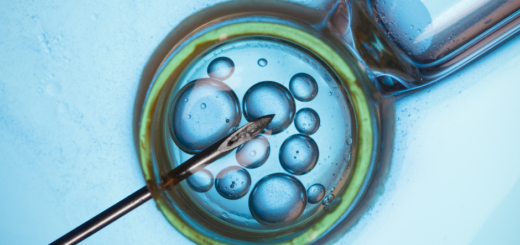Ovarian Cyst: Size, Complications & Management

Ovarian cysts are fluid-filled bubbles like growths in women. In most instances, they are incidentally seen during the pelvic ultrasounds. Simple cysts do not cause any medical issues. At times, cysts can cause serious complications like rupture, bleeding, and twisting. These are emergency conditions. Hence it is important to diagnose such conditions and take precautions to prevent life-threatening situations.
What are ovarian cysts?
Ovaries are the reproductive organs in the female responsible for producing eggs. These are structures by the sides of the uterus along with the Fallopian tubes. The ovaries are freely hanging structures in the pelvis covered by folds of the peritoneum. In young women, the ovaries function to produce several eggs a month. Out of these growing eggs, only one matures and ovulates. Following ovulation, the mature follicle can turn into a fluid-filled sac called an ovarian cyst. There are various types of cysts identified in ovaries.
Types of cysts in the ovary
Not all ovarian masses are cysts, the cysts are different from ovarian masses. In young women most ovarian cysts are functional. These are benign, and do not require surgical intervention until their size is huge. However, some ovarian cysts can lead to complications. Pelvic pain, cyst rupture, blood loss are some of the common complications.
Different types of cysts seen in ovaries
Functional or follicular cysts
It occurs during the course of the normal menstrual cycle. These are follicles that fail to release the egg during ovulation. These cysts have a single cavity with a thin wall & appear regular. High FSH level with our LH surge may cause such growths. These are usually small in size and may produce estrogen hormone. As a result, these cysts may cause disruption of the menstrual cycle.
Corpus Luteal Cysts
Usually the corpus luteum regresses if pregnancy fails to occur. Its life span is around 14 days after which dissolution occurs. If this regression doesn’t happen it persists as a luteal cyst. In pregnant women these cysts continue secreting hormone progesterone till 12 weeks.
Theca Lutein Cysts
These are fluid filled follicular cysts occurring due to hyperstimulation by HCG hormone. These cysts occur in pregnancy or in ovarian hyperstimulation during IVF treatment. Women with twin pregnancy are more likely to have them.
Ovarian tumors
These are also cyst overgrowths in the ovaries which may be cancerous. Usually these are partially cystic arising from the surface of the ovary. Dermoid tumors are complex cystic growths which can contain a variety of tissues like hair, teeth etc.
PCOS
Polycystic ovary syndrome (PCOS) occurs in young women and presents with irregular cycle and infertility. Both the ovaries are enlarged with many small follicular cysts. It is a hormone dependent situation, usually associated with diabetes mellitus.
Endometriosis
Unwanted presence of endometrial glands and stroma at sites outside the uterus causes endometriosis. Ovaries are the most common sites for chocolate cysts filled with dark and thick blood.
What causes ovarian cysts?
Follicular growth and maturation in the ovary depend on the action of the hormone FSH.
Follicle-stimulating hormone is important for dominant follicle selection and estrogen production. The dominant follicle grows and produces a mature egg for release into the Fallopian tube. If this process of ovulation doesn’t happen the follicle turns into a cyst.
Who is at risk of cyst formation?
Patients undergoing fertility treatment like ovarian induction, IUI, or IVF – ovulation induction agents and gonadotropins cause hyperstimulation and give rise to cysts.
- Pregnant women
- Hypothyroidism
- At times female babies may develop cysts under influence of maternal gonadotropins.
- Cigarette smoking
- After tubal sterilization operation
Diagnosis of ovarian cyst
When you are having an ovarian cyst your doctor will check the urine pregnancy test first. If you are pregnant, then the cyst may not be of any importance. Pregnant women often have corpus luteum cysts till 12 weeks. These cysts regress spontaneously and rarely require surgical interventions. If the pregnancy test is negative, your doctor will advise further tests to know the nature of the cyst. After exclusion of pregnancy, she will proceed for an ultrasound of the pelvis. Infection screening for urinary tract and reproductive organs is mandatory for all patients with cysts. Older women will require ovarian cancer screening with cancer antigen CA 125.
Transvaginal ultrasound is a better imaging option for the evaluation of pelvic anatomy. Color Doppler study of cysts can delineate the nature and aggressiveness. Larger cysts need a more definite diagnosis. Women above 60 years have more chances of cancerous growth.
What are the management options for ovarian cysts?
Functional cysts
If you have ovarian cysts found in ultrasound, no need to panic. Most of these cysts resolve within 2 to 3 months without any treatment. At times, your doctor may advise contraceptive pills for 3 cycles to hasten the resolution process. Cysts smaller than 5 cm without any complications are treated in this way. These cases will require periodic ultrasound monitoring.
Complex cysts
Larger or complex cysts, cysts with complications and suspicion for cancer will need surgical treatment. Elderly women will require more vigilance even if cyst size is smaller. If cysts persist even after several menstrual cycles, it will need definite treatment.
Cysts in female newborns
Ovarian cysts seen in newborn babies are due to hormonal stimulation. Pregnant mothers with diabetes and hypothyroidism are more likely to have babies with ovarian cysts. These cysts dissolve without any complications within 3 months of birth.
Corpus luteal cysts
These are pregnancy-associated cysts and don’t require any treatment. Corpus luteal cysts resolve by 14 to 16 weeks of pregnancy spontaneously. Bigger cysts may need to follow up with less than a 1% chance of cancer transformation.
Endometriosis
It is a painful condition and requires symptomatic management. These cysts don’t dissolve and grow over time. Regular ultrasound check and surgical removal when necessary is the treatment of choice. Medical treatment may suppress the pain for some time and allow the woman to complete fertility treatment.
Surgical treatment for ovarian cyst
Surgery is advised in certain situations like
- Large ovarian cysts
- Failure of medical treatment
- Painful endometrioma
- Complications like bleeding, rupture, or twisting
- Cancer suspicion
Laparoscopic removal is a safe option and allows early recovery.
Complications
There are three classic complications of ovarian cyst that commonly present to the emergency department:
- Rupture- Few cysts can burst after size becomes bigger. This will require immediate surgical intervention to save a life.
- Hemorrhage – Bleeding inside the cyst will cause pain and requires immediate removal. The patient may collapse if heavy bleeding continues.
- Torsion – Ovarian cysts are fluid-filled sacs that can rotate when size increases. Twisting single or multiple times gives rise to an emergency situation called torsion.
- Infection – Long-standing cysts may become infected and need treatment.




















Hi I was missed my period for a month and took herbs immediately i saw blood and just like that it started coming out till the next month making it 15 days,it comes out with dark clots but I don’t feel pain atall just gassy sounds and a sharp feeling on my right side belly then I went for an untrasound and was diagnosed with a right simple ovarian cyst.
And small intracavitary blood clots ? DUB
Pls what can I do to stop the blood
I feel weak and should I be worried about the cyst
I would suggest you not to take any herbs for periods, many of them contain some quantity of estrogen hormone and can cause ovarian cyst. Simple ovarian cysts are usually treated with medicines, please consult your doctor for further action.